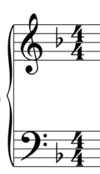Grade 3 Flashcards
What is the difference between simple and compound time
Simple time: the beat of the bar can divide easily into TWO equal parts
Compound time: the beat of the bar can divide easily into THREE equal parts
Is this simple or compound time?

Simple time as the beat of the bar can be divided easily into 2

Is this simple or compound time?

Simple time as the beat of the bar can be divided easily into 2

Is this simple or compound time?

Simple time as the beat of the bar can be divided easily into 2

Is this simple or compound time?

Compound time as the beat of the bar can be divided easily into 3

Is this simple or compound time?

Compound time as the beat of the bar can be divided easily into 3

Is this simple or compound time?

Compound time as the beat of the bar can be divided easily into 3

What is an anacrusis?
Describes the note or notes of a piece that a composer often writes before the first full part

What does this symbol represent?

Up-bow marking for string players
What does this symbol represent?

Down-bow marking for string players
Which degrees of the melodic minor scale are a semitone apart?
2-3 semitone
7-8 semitone
(note the 6th and 7th degrees are raised by a semitone going up)

G major key signature
F sharp

D major key signature
F sharp
C sharp

F major key signature
B flat

B flat major key signature
B flat
E flat

C major key signature
no sharps and flats

A minor key signature
no sharps and flats

E minor key signature
F sharp

B minor key signature
F sharp
C sharp

D minor key signature
B flat

G minor key signature
B flat
E flat

This key signature is for which major key scale?

C major
This key signature is for which minor key scale?

A minor
This key signature is for which major key scale?

F major




















































